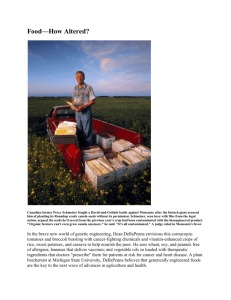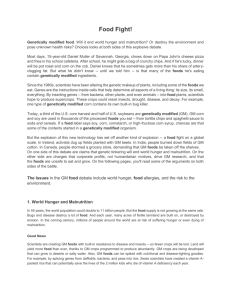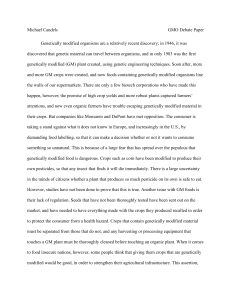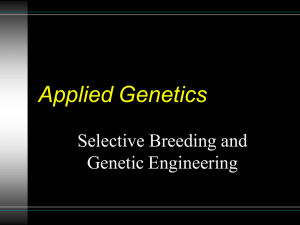National Geographic Article GMO`s
advertisement
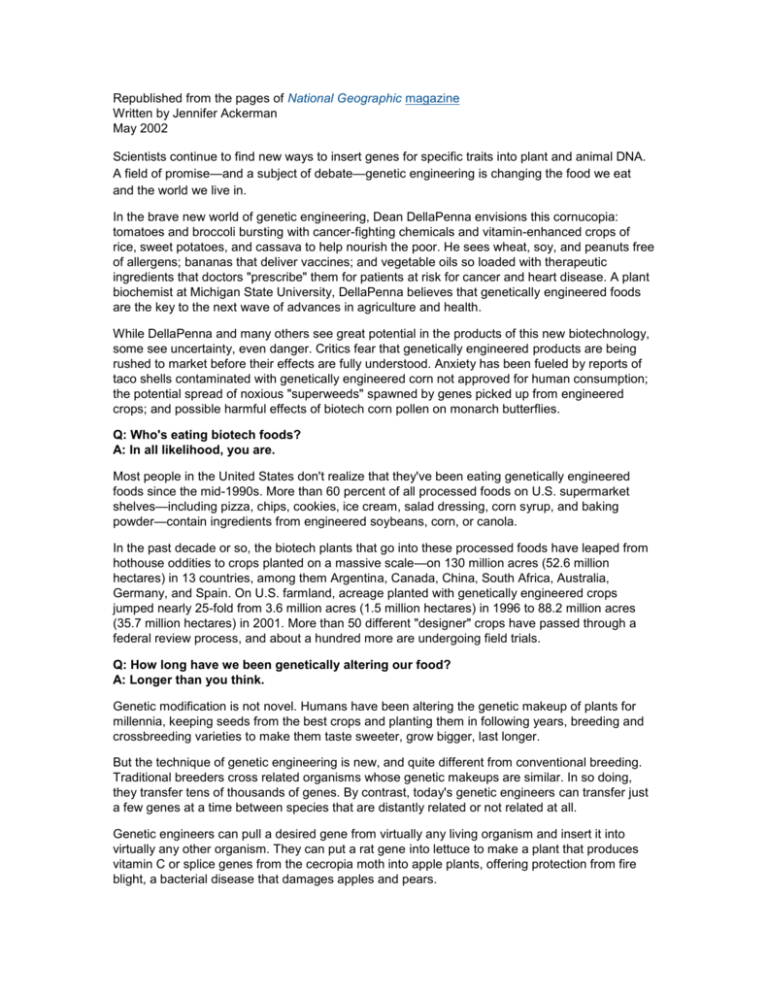
Republished from the pages of National Geographic magazine Written by Jennifer Ackerman May 2002 Scientists continue to find new ways to insert genes for specific traits into plant and animal DNA. A field of promise—and a subject of debate—genetic engineering is changing the food we eat and the world we live in. In the brave new world of genetic engineering, Dean DellaPenna envisions this cornucopia: tomatoes and broccoli bursting with cancer-fighting chemicals and vitamin-enhanced crops of rice, sweet potatoes, and cassava to help nourish the poor. He sees wheat, soy, and peanuts free of allergens; bananas that deliver vaccines; and vegetable oils so loaded with therapeutic ingredients that doctors "prescribe" them for patients at risk for cancer and heart disease. A plant biochemist at Michigan State University, DellaPenna believes that genetically engineered foods are the key to the next wave of advances in agriculture and health. While DellaPenna and many others see great potential in the products of this new biotechnology, some see uncertainty, even danger. Critics fear that genetically engineered products are being rushed to market before their effects are fully understood. Anxiety has been fueled by reports of taco shells contaminated with genetically engineered corn not approved for human consumption; the potential spread of noxious "superweeds" spawned by genes picked up from engineered crops; and possible harmful effects of biotech corn pollen on monarch butterflies. Q: Who's eating biotech foods? A: In all likelihood, you are. Most people in the United States don't realize that they've been eating genetically engineered foods since the mid-1990s. More than 60 percent of all processed foods on U.S. supermarket shelves—including pizza, chips, cookies, ice cream, salad dressing, corn syrup, and baking powder—contain ingredients from engineered soybeans, corn, or canola. In the past decade or so, the biotech plants that go into these processed foods have leaped from hothouse oddities to crops planted on a massive scale—on 130 million acres (52.6 million hectares) in 13 countries, among them Argentina, Canada, China, South Africa, Australia, Germany, and Spain. On U.S. farmland, acreage planted with genetically engineered crops jumped nearly 25-fold from 3.6 million acres (1.5 million hectares) in 1996 to 88.2 million acres (35.7 million hectares) in 2001. More than 50 different "designer" crops have passed through a federal review process, and about a hundred more are undergoing field trials. Q: How long have we been genetically altering our food? A: Longer than you think. Genetic modification is not novel. Humans have been altering the genetic makeup of plants for millennia, keeping seeds from the best crops and planting them in following years, breeding and crossbreeding varieties to make them taste sweeter, grow bigger, last longer. But the technique of genetic engineering is new, and quite different from conventional breeding. Traditional breeders cross related organisms whose genetic makeups are similar. In so doing, they transfer tens of thousands of genes. By contrast, today's genetic engineers can transfer just a few genes at a time between species that are distantly related or not related at all. Genetic engineers can pull a desired gene from virtually any living organism and insert it into virtually any other organism. They can put a rat gene into lettuce to make a plant that produces vitamin C or splice genes from the cecropia moth into apple plants, offering protection from fire blight, a bacterial disease that damages apples and pears. The engineered organisms scientists produce by transferring genes between species are called transgenic. Several dozen transgenic food crops are currently on the market, among them varieties of corn, squash, canola, soybeans, and cotton, from which cottonseed oil is produced. Most of these crops are engineered to help farmers deal with age-old agriculture problems: weeds, insects, and disease. Farmers spray herbicides to kill weeds. Biotech crops can carry special "tolerance" genes that help them withstand the spraying of chemicals that kill nearly every other kind of plant. Some biotech varieties make their own insecticide, thanks to a gene borrowed from a common soil bacterium, Bacillus thuringiensis, or Bt for short. Bt genes code for toxins considered to be harmless to humans but lethal to certain insects. So effective is Bt that organic farmers have used it as a natural insecticide for decades, albeit sparingly. Corn borer caterpillars bite into the leaves, stems, or kernels of a Bt corn plant, the toxin attacks their digestive tracts, and they die within a few days. Other food plants—squash and papaya, for instance—have been genetically engineered to resist diseases. Lately scientists have been experimenting with potatoes, modifying them with genes of bees and moths to protect the crops from potato blight fungus, and grapevines with silkworm genes to make the vines resistant to Pierce's disease, spread by insects. With the new tools of genetic engineering, scientists have also created transgenic animals. Atlantic salmon grow more slowly during the winter, but engineered salmon, "souped-up" with modified growth-hormone genes from other fish, reach market size in about half the normal time. Scientists are also using biotechnology to insert genes into cows and sheep so that the animals will produce pharmaceuticals in their milk. None of these transgenic animals have yet entered the market. Q: Are biotech foods safe for humans? A: Yes, as far as we know. "Risks exist everywhere in our food supply," points out Dean DellaPenna. "About a hundred people die each year from peanut allergies. With genetically engineered foods we minimize risks by doing rigorous testing." According to Eric Sachs, a spokesperson for Monsanto, a leading developer of biotech products: "Transgenic products go through more testing than any of the other foods we eat. We screen for potential toxins and allergens. We monitor the levels of nutrients, proteins, and other components to see that the transgenic plants are substantially equivalent to traditional plants." Three federal agencies regulate genetically engineered crops and foods—the U.S. Department of Agriculture (USDA), the Environmental Protection Agency (EPA), and the Food and Drug Administration (FDA). The FDA reviews data on allergens, toxicity, and nutrient levels voluntarily submitted by companies. Last year the agency proposed tightening its scrutiny of engineered foods, making the safety assessments mandatory rather than voluntary. In the mid-1990s a biotech company launched a project to insert a gene from the Brazil nut into a soybean. The Brazil nut gene selected makes a protein rich in one essential amino acid. The aim was to create a more nutritious soybean for use in animal feed. Because the Brazil nut is known to contain an allergen, the company also tested the product for human reaction, with the thought that the transgenic soybean might accidentally enter the human food supply. When tests showed that humans would react to the modified soybeans, the project was abandoned. For some people this was good evidence that the system of testing genetically engineered foods works. But for some scientists and consumer groups, it raised the specter of allergens or other hazards that might slip through the safety net. Scientists know that some proteins, such as the one in the Brazil nut, can cause allergic reactions in humans, and they know how to test for these allergenic proteins. But the possibility exists that a novel protein with allergenic properties might turn up in an engineered food—just as it might in a new food produced by conventional means— and go undetected. Furthermore, critics say, the technique of moving genes across dramatically different species increases the likelihood of something going awry—either in the function of the inserted gene or in the function of the host DNA—raising the possibility of unanticipated health effects. An allergy scare in 2000 centered around StarLink, a variety of genetically engineered corn approved by the U.S. government only for animal use because it showed some suspicious qualities, among them a tendency to break down slowly during digestion, a known characteristic of allergens. When StarLink found its way into taco shells, corn chips, and other foods, massive and costly recalls were launched to try to remove the corn from the food supply. Often overlooked in the debate about the health effects of these foods is one possible health benefit: Under some conditions corn genetically engineered for insect resistance may enhance safety for human and animal consumption. Corn damaged by insects often contains high levels of fumonisins, toxins made by fungi that are carried on the backs of insects and that grow in the wounds of the damaged corn. Lab tests have linked fumonisins with cancer in animals, and they may be potentially cancer-causing to humans. Among people who consume a lot of corn—in certain parts of South Africa, China, and Italy, for instance—there are high rates of esophageal cancer, which scientists associate with fumonisins. Studies show that most Bt corn has lower levels of fumonisins than conventional corn damaged by insects. Should genetically engineered foods be labeled? Surveys suggest that most Americans would say yes (although they wouldn't want to pay more for the labeling). No engineered foods currently carry labels in the U.S. because the FDA has not found any of them to be substantially different from their conventional counterparts. Industry representatives argue that labeling engineered foods that are not substantially different would arouse unwarranted suspicion. Q: Can biotech foods harm the environment? A: It depends on whom you ask. Most scientists agree: The main safety issues of genetically engineered crops involve not people but the environment. "We've let the cat out of the bag before we have real data, and there's no calling it back," says Allison Snow, a plant ecologist at Ohio State University. Snow is known for her research on "gene flow," the movement of genes via pollen and seeds from one population of plants to another, and she and some other environmental scientists worry that genetically engineered crops are being developed too quickly and released on millions of acres of farmland before they've been adequately tested for their possible long-term ecological impact. Advocates of genetically engineered crops argue that the plants offer an environmentally friendly alternative to pesticides, which tend to pollute surface and groundwater and harm wildlife. The use of Bt varieties has dramatically reduced the amount of pesticide applied to cotton crops. But the effects of genetic engineering on pesticide use with more widely grown crops are less clearcut. Concerns that crops with built-in insecticides might damage wildlife were inflamed in 1999 by the report of a study suggesting that Bt corn pollen harmed monarch butterfly caterpillars. Monarch caterpillars don't feed on corn pollen, but they do feed on the leaves of milkweed plants, which often grow in and around cornfields. Entomologists at Cornell University showed that in the laboratory Bt corn pollen dusted onto milkweed leaves stunted or killed some of the monarch caterpillars that ate the leaves. For some environmental activists this was confirmation that genetically engineered crops were dangerous to wildlife. But follow-up studies in the field, reported last fall, indicate that pollen densities from Bt corn rarely reach damaging levels on milkweed, even when monarchs are feeding on plants within a cornfield. "The chances of a caterpillar finding Bt pollen doses as high as those in the Cornell study are negligible," says Rick Hellmich, an entomologist with the Agricultural Research Service and one author of the follow-up report. "Butterflies are safer in a Bt cornfield than they are in a conventional cornfield, when they're subjected to chemical pesticides that kill not just caterpillars but most insects in the field." Perhaps a bigger concern has to do with insect evolution. Crops that continuously make Bt may hasten the evolution of insects impervious to the pesticide. Such a breed of insect, by becoming resistant to Bt, would rob many farmers of one of their safest, most environmentally friendly tools for fighting the pests. To delay the evolution of resistant insects, U.S. government regulators, working with biotech companies, have devised special measures for farmers who grow Bt crops. Farmers must plant a moat or "refuge" of conventional crops near their engineered crops. The idea is to prevent two resistant bugs from mating. The few insects that emerge from Bt fields resistant to the insecticide would mate with their nonresistant neighbors living on conventional crops nearby; the result could be offspring susceptible to Bt. The theory is that if growers follow requirements, it will take longer for insects to develop resistance. Many ecologists believe that the most damaging environmental impact of biotech crops may be gene flow. Could transgenes that confer resistance to insects, disease, or harsh growing conditions give weeds a competitive advantage, allowing them to grow rampantly? "Genes flow from crops to weeds all the time when pollen is transported by wind, bees, and other pollinators," says Allison Snow. "There's no doubt that transgenes will jump from engineered crops into nearby relatives." But since gene flow usually takes place only between closely related species, and since most major U.S. crops don't have close relatives growing nearby, it's extremely unlikely that gene flow will occur to create problem weeds. Still, Snow says, "even a very low probability event could occur when you're talking about thousands of acres planted with food crops." And in developing countries, where staple crops are more frequently planted near wild relatives, the risk of transgenes escaping is higher. While no known superweeds have yet emerged, Snow thinks it may just be a matter of time. Q: Can biotech foods help feed the world? A: There are obstacles to overcome. "Eight hundred million people on this planet are malnourished," says Channapatna Prakash, a native of India and an agricultural scientist at the Center for Plant Biotechnology Research at Tuskegee University, "and the number continues to grow." Genetic engineering can help address the urgent problems of food shortage and hunger, say Prakash and many other scientists. It can increase crop yields, offer crop varieties that resist pests and disease, and provide ways to grow crops on land that would otherwise not support farming because of drought conditions, depleted soils, or soils plagued by excess salt or high levels of aluminum and iron. "This technology is extremely versatile," Prakash explains, "and it's easy for farmers to use because it's built into the seed. The farmers just plant the seeds, and the seeds bring new features in the plants." Some critics of genetic engineering argue that the solution to hunger and malnutrition lies in redistributing existing food supplies. Others believe that the ownership by big multinational companies of key biotechnology methods and genetic information is crippling public-sector efforts to use this technology to address the needs of subsistence farmers. The large companies that dominate the industry, critics also note, are not devoting significant resources to developing seed technology for subsistence farmers because the investment offers minimal returns. And by patenting key methods and materials, these companies are stifling the free exchange of seeds and techniques vital to public agricultural research programs, which are already under severe financial constraints. All of this bodes ill, say critics, for farmers in the developing world. Prakash agrees that there's enough food in the world. "But redistribution is just not going to happen," he says. "The protest against biotech on political grounds is a straw man for a larger frustration with globalization, a fear of the power of large multinational corporations. People say that this technology is just earning profit for big companies. This is true to some extent, but the knowledge that companies have developed in the production of profitable crops can easily be transferred and applied to help developing nations." "Biotechnology is no panacea for world hunger," says Prakash, "but it's a vital tool in a toolbox, one that includes soil and water conservation, pest management, and other methods of sustainable agriculture, as well as new technologies." The debate over the use of biotechnology in developing countries recently went from simmer to boil about rice, which is eaten by three billion people and grown on hundreds of millions of small farms. "White rice," explains Dean DellaPenna, "is low in protein. It has very little iron, and virtually no vitamin A."However, in 1999 a team of scientists led by Ingo Potrykus, of the Swiss Federal Institute of Technology, and Peter Beyer, of the University of Freiburg, Germany, announced a new breakthrough: They had introduced into rice plants two daffodil genes and one bacterial gene that enable the rice to produce in its grains beta-carotene, a building block of vitamin A. According to the World Health Organization, between 100 million and 140 million children in the world suffer from vitamin A deficiency, some 500,000 go blind every year because of that deficiency, and half of those children die within a year of losing their sight. "Golden rice," so named for the yellow color furnished by the beta-carotene, was hailed by some as a potential solution to the suffering and illness caused by vitamin A deficiency. Skeptics consider golden rice little more than a public relations ploy by the biotechnology industry, which they say exaggerated its benefits. "Golden rice alone won't greatly diminish vitamin A deficiency," says Marion Nestle. "Beta-carotene, which is already widely available in fruit and vegetables, isn't converted to vitamin A when people are malnourished. Golden rice does not contain much beta-carotene, and whether it will improve vitamin A levels remains to be seen." Potrykus and Beyer are now developing new versions of the rice that may be more effective in delivering beta-carotene for the body to convert to vitamin A. Their plan is to put the improved rices free of charge into the hands of poor farmers. According to Beyer, golden rice is still at least four years away from distribution. It could take much longer if opposing groups delay plans for field trials and safety studies. Q: What next? A: Proceed with caution. Whether biotech foods will deliver on their promise of eliminating world hunger and bettering the lives of all remains to be seen. Their potential is enormous, yet they carry risks—and we may pay for accidents or errors in judgment in ways we cannot yet imagine. But the biggest mistake of all would be to blindly reject or endorse this new technology. If we analyze carefully how, where, and why we introduce genetically altered products, and if we test them thoroughly and judge them wisely, we can weigh their risks against their benefits to those who need them most.
